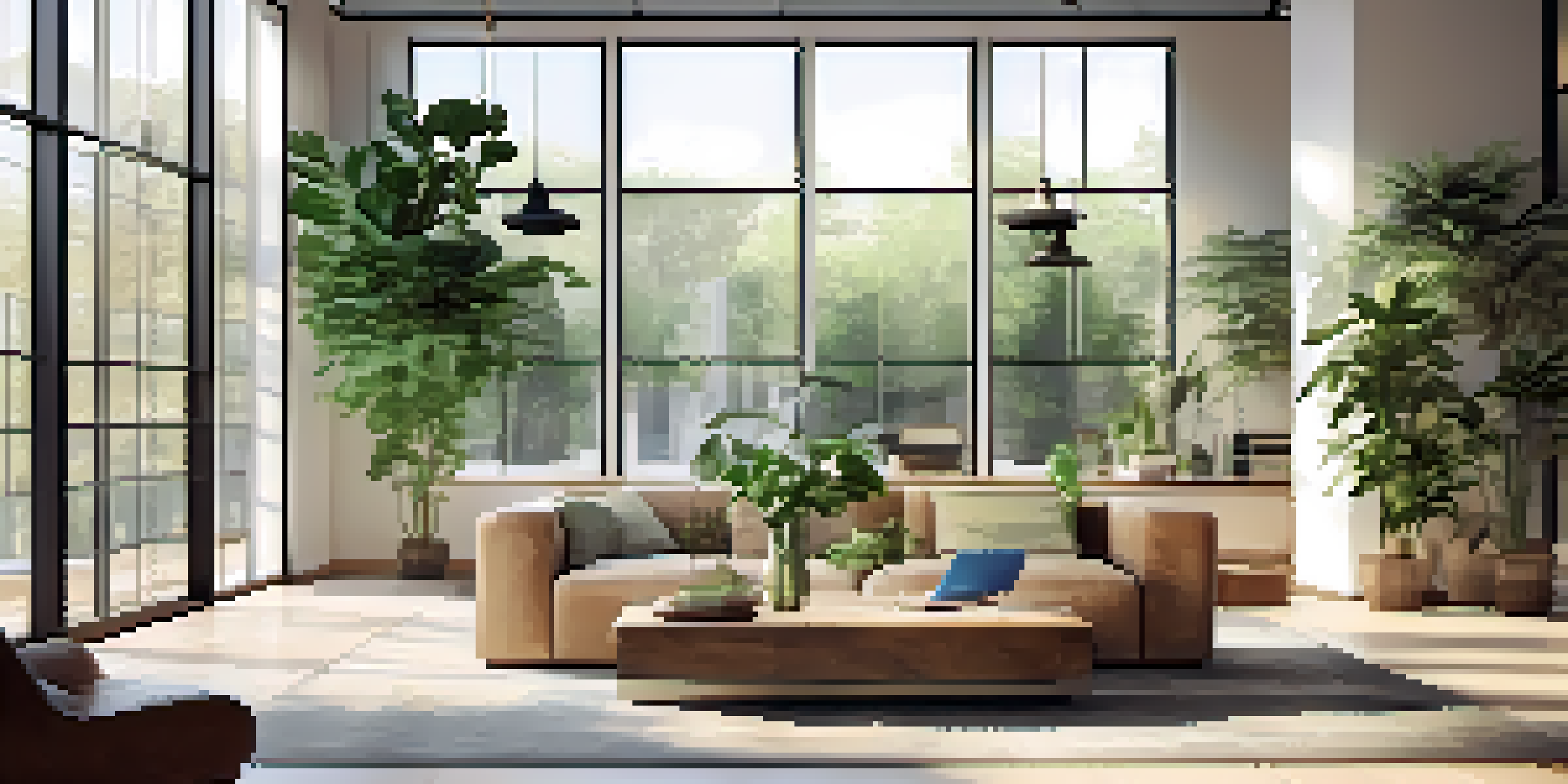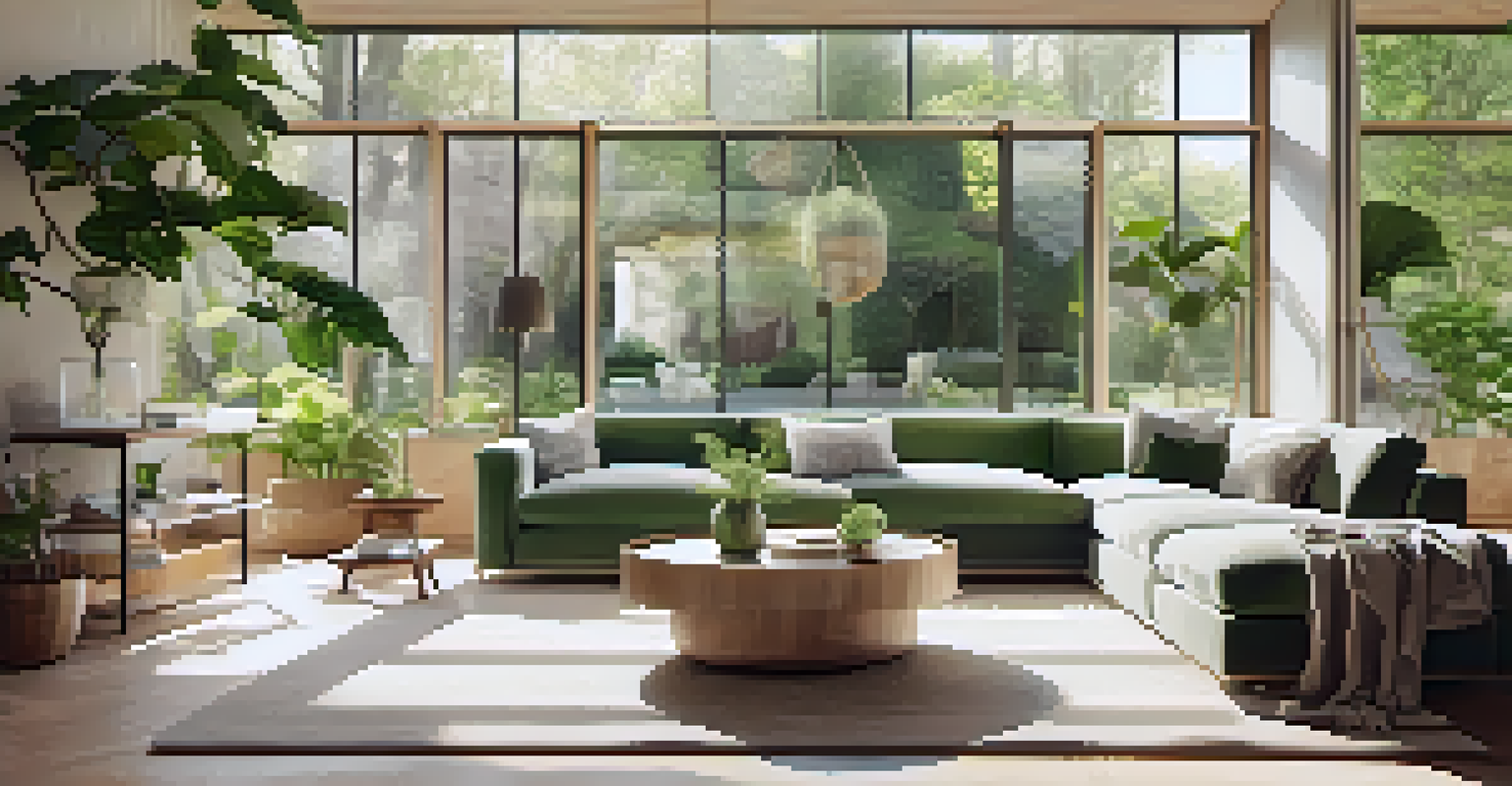The Significance of Indoor Air Quality in Sustainable Design

What is Indoor Air Quality and Why Does It Matter?
Indoor air quality (IAQ) refers to the air quality within buildings and structures, especially as it relates to the health and comfort of occupants. It encompasses various factors, including the presence of pollutants, humidity levels, and temperature. Poor IAQ can lead to health issues like allergies, respiratory problems, and even long-term diseases, making it a critical aspect of any indoor environment.
The air inside our homes can be more polluted than the air outside, and we spend 90% of our time indoors.
The significance of IAQ extends beyond just health; it impacts productivity and overall well-being. For instance, studies show that better air quality in workplaces can enhance employee performance and reduce sick days. This connection highlights why architects and designers are increasingly prioritizing IAQ in their sustainable design practices.
Incorporating natural ventilation, using non-toxic materials, and maintaining optimal humidity levels are some strategies to improve IAQ. By focusing on these elements, designers not only create healthier spaces but also contribute to the sustainability of the environment. It's a win-win situation that reflects a growing awareness of our built surroundings.
The Role of Sustainable Design in Enhancing IAQ
Sustainable design aims to minimize the negative environmental impact of buildings while maximizing efficiency and comfort. A key component of this approach is improving indoor air quality through thoughtful design choices. For example, using sustainable materials that emit fewer volatile organic compounds (VOCs) can significantly reduce indoor pollutants.

Incorporating green spaces, such as indoor plants, can also enhance IAQ. Plants naturally filter toxins and release oxygen, creating a healthier atmosphere for occupants. By integrating nature within the design, we not only beautify spaces but also promote better air quality.
Indoor Air Quality Affects Health
Poor indoor air quality can lead to serious health issues, including allergies and respiratory problems.
Moreover, designing buildings with energy efficiency in mind can facilitate better air circulation. Innovative systems can help maintain a balance between energy savings and sufficient fresh air intake. This focus on sustainable design principles ultimately leads to healthier, more livable spaces.
Common Pollutants Impacting Indoor Air Quality
Indoor air can be polluted by various substances, including dust, mold, pet dander, and chemical fumes from household products. These pollutants can accumulate over time, leading to diminished air quality and potential health risks. Understanding the sources of these contaminants is crucial for anyone looking to improve their indoor environment.
Good indoor air quality is a critical component of a healthy environment, and it can be achieved through careful design and regular maintenance.
For instance, household cleaners and paints can release harmful chemicals into the air. Opting for eco-friendly alternatives can significantly reduce these emissions. Additionally, regular cleaning and maintenance of HVAC systems can help eliminate dust and allergens, ensuring a healthier indoor space.
Recognizing the common culprits of indoor air pollution empowers individuals and designers to take proactive steps toward improvement. By being mindful of the materials and practices used in our spaces, we can create healthier environments that support our well-being.
The Benefits of Improved Indoor Air Quality
Improving indoor air quality offers numerous benefits, both immediate and long-term. Healthier air can lead to fewer respiratory issues, enhanced cognitive function, and a greater sense of well-being. This is particularly vital in spaces like schools and offices, where people spend a significant portion of their day.
Better IAQ can also lead to increased productivity. When employees breathe cleaner air, they're more likely to focus and perform optimally. This translates into tangible benefits for businesses, such as higher output and lower turnover rates.
Sustainable Design Enhances IAQ
Incorporating sustainable design practices, such as natural ventilation and eco-friendly materials, significantly improves indoor air quality.
Moreover, investing in air quality improvements can enhance property values. Buildings that prioritize health and comfort are increasingly sought after in the real estate market. This reinforces the idea that good design not only looks good but also pays off in more ways than one.
Integrating Natural Ventilation in Design
Natural ventilation is an effective strategy for improving indoor air quality. By allowing fresh air to flow through a building, designers can significantly reduce the concentration of indoor pollutants. This approach can be achieved through strategically placed windows, vents, and atriums that promote airflow.
Incorporating natural ventilation not only enhances IAQ but also reduces reliance on mechanical systems. This can lead to energy savings and a smaller carbon footprint. For instance, buildings designed with cross-ventilation in mind can maintain comfortable temperatures without air conditioning.
However, it's essential to consider local climate and building location when designing for natural ventilation. Effective strategies will vary based on these factors, but when done right, the benefits are substantial. This practice aligns with sustainable design principles, fostering healthier environments that work in harmony with nature.
The Importance of Regular IAQ Assessments
Regular assessments of indoor air quality are crucial for maintaining a healthy environment. By routinely measuring levels of pollutants, humidity, and ventilation rates, building managers can identify potential issues before they escalate. This proactive approach helps ensure that spaces remain safe and comfortable for occupants.
Implementing IAQ monitoring systems can provide real-time data on air quality conditions. These systems can alert managers to any changes that may require immediate attention, such as increased levels of VOCs or drops in ventilation. In this way, technology plays a vital role in maintaining optimal air quality.
Regular Assessments Ensure Safety
Routine assessments of indoor air quality help identify potential issues, ensuring a safe and comfortable environment for occupants.
Furthermore, regular assessments can guide future design and renovation choices. Understanding how indoor air quality fluctuates can inform decisions about materials, layouts, and systems. By prioritizing IAQ in ongoing evaluations, we can create spaces that continue to support health and sustainability over time.
Future Trends in Indoor Air Quality and Design
As awareness of the importance of indoor air quality continues to grow, new trends are emerging in sustainable design. Innovations in building materials, such as air-purifying paints and self-cleaning surfaces, are being developed to reduce pollutants. These advancements are paving the way for healthier indoor environments.
Smart technology is also making a significant impact, with devices that monitor air quality and adjust ventilation automatically. This level of control can enhance comfort and efficiency, ensuring that occupants always breathe clean air. The integration of technology into design is transforming how we think about and manage our indoor spaces.

Looking ahead, the emphasis on health and well-being in design will likely increase. As more people recognize the link between IAQ and quality of life, sustainable design practices will evolve to prioritize health-centric solutions. This shift promises to create environments that not only look good but also feel good.